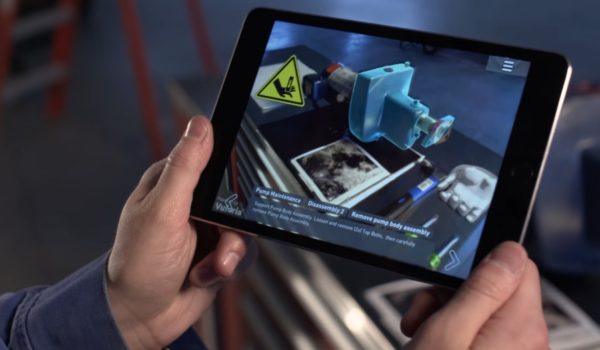Enterprises are optimistic about the potential of virtual and augmented reality, according to a recent report by Perkins Coie in collaboration with XR Association trade group and venture capital firm Boost VC.
Two-thirds of companies expect to increase spending on immersive technologies this year compared to 2019, the report said, with more interest in augmented reality applications than in VR.
”Augmented reality can drive real business value and the industry now has the numbers to prove it, to the point where many Fortune 100 companies are taking notice and figuring out the right use cases for their business,” said David Nedohin, Chief Customer Officer and co-founder of Scope AR, an AR-powered employee training platform.
“The C-suite is now a part of the conversation in AR deployments as we’re seeing repeatable and consistent ROI numbers from various customers,” Nedohin told Hypergrid Business.

Scope AR recently released a quick start program for companies looking to manage remote operations during the COVID-19 pandemic, and is offering its WorkLink solution for free to groups working on creating ventilators.
Given the current health situation as a result of the coronavirus outbreak, we are seeing the growth of the use of collaborative business productivity tools, like videoconferencing and people are using it together with AR. Companies can use these to undertake workforce development and training remotely, more safely and less expensively than in-person development and training, during the lockdowns as a result of coronavirus outbreak.
“For instance, given the uptick in videoconferencing use in our new work from home environment, people are getting excited about AR overlays that give users the ability to replace a background without a green screen,” Perkins Coie’s interactive entertainment practice co-chair Kirk Soderquist told Hypergrid business. “There will also very likely be an increased demand for connectivity solutions that are more private and flexible than a webcam and computer monitor. Couple this with an ability to move or create a shared space and it becomes a very compelling experience.”
However, gaming and entertainment, including social media, television and events, are still the primary driver behind the use of AR and other immersive technologies. Outside gaming and entertainment, health care and medical applications are expected to see the most adoption, said Perkins Coie researchers, and the pandemic may help drive adoption.
And enterprises use can help spur consumer adoption, he added. People who use AR or VR technology at work may be more willing to try it out at home.
“We saw it with desktop computers, laptop computers, Blackberry devices, and in the transition into smartphones and we will also see it in VR and AR technology too,” said Soderquist.
According to the survey, the two biggest obstacles for the adoption of AR and VR technologies were problems with the user experience and the lack of content.
That will take time, said Juan Kuang, an analyst at Greenlight Insights.
”When hardware is comfortable and functional enough to replace more than 85 percent of traditional computing tasks, such as web browsing, we will begin to see true mass adoption,” Kuang told Hypergrid Business. ”Three to four years is certainly enough time to build a very compelling hardware platform, but is relatively little time for the massive cultural and infrastructural changes necessary for average consumers to see VR as anything other than a niche product.’
Although low-end devices have very many applications and play an important role in helping entry of many into VR and AR, they require more conputing power and connectivity so as to provide smooth VR and AR experiences. Users of these low end devices will tend to gravitate towards using high-end devices as they continue to gain more experience with VR and AR as they will be looking for devices that will offet them better experiences.
“Adoption will be more rapid and broad if there is a specific, everyday use case that provides a compelling alternative to non-AR/VR solutions, or can do something useful that a non-AR/VR solution cannot,” said Soderquist. “Consumers and non-enterprise users – low end as they get used to and understand the technology, trending towards the high end like how we saw the transition from blackberries to smartphones.”
- OpenSim active users hit all-time-high for the holidays - December 15, 2023
- OpenSim user activity ramping up for the holidays - November 15, 2023
- OpenSim land area at a new high as grids prep for holidays - October 15, 2023
